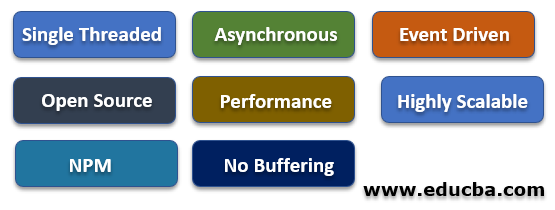Updated June 6, 2023
Introduction to Features of Node.js
Today we will be learning about the features of Node.js, which allows us to create real-time-based, highly scalable data-intensive applications, and how the asynchronous working makes it easier for the user to access the data.
Also, we will look into the event-driven concept and walk through the Event module, its EventEmitter class, with its methods. Learn how Node.js achieves extremely high performance while operating through a single thread. Callback functions concept, which allows users to run applications without a buffer.
Top Features of Node.js
First, let us list down the features of Node.js and later understand them in detail:
1. Single Threaded
Node.js operates on a single thread. It is based on the “Single Threaded Event Loop Model” architecture which can handle multiple client requests. A single thread executes the main event loop. Still, in the background, the input-output work is performed on separate threads, as Node API’s input-output operation is asynchronous (non-blocking design) to accommodate the Event Loop. Event Loop is what allows node.js to perform all the non-blocking operations.
2. Asynchronous
Node.js is asynchronous by default, i.e., it operates non-blocking. When a client requests a server, a single thread handles the request; it checks if the request involves any database interaction. If it does not, we process the request, and the server returns the response to the client. The thread is ready to handle the next request.
3. Event Driven
The event-driven concept is similar to the concept of a callback function in asynchronous programming. The only difference is that the callback function executes once the asynchronous function returns its result, triggering events on its associated event handler. Node provides a module called “Event” which consists of an “EventEmitter” class that allows us to implement event-driven programming. An Event handler is a function called when an event is triggered. A main loop listens to the triggers and calls the corresponding event handler.
EventEmitter consists of various methods, one of which is the emit(); that fires an event. Emit() has the first argument as the event’s name; the next arguments are used to pass data. The on() method listens to the event that is emitted and executes it. Event-driven programming makes Node pretty fast and gives high performance.
4. Open Source
Node.js is open-source, which means it is free to use. We can install Node.js from https://nodejs.org/en/ according to our platform.
5. Performance
Google Chrome’s V8 JavaScript engine is the foundation of Node.js, enabling faster code execution. The engine compiles the JavaScript code into machine code which makes our code easier and faster to implement effectively. Concepts like asynchronous programming and its operation on non-blocking input-output operations make its performance high. Node.js uses events highly, which makes it pretty fast.
6. Highly Scalable
Node.js applications are highly scalable as they operate asynchronously (non-blocking). Node.js works on a Single thread, where when a single request arrives, it starts processing it and is ready to handle the next request. Once we prepare the response, we send it back to the client.
7. Node Package Manager(NPM)
As we know, the Node Package Manager is a package manager for Node JavaScript runtime environment and is a recommended feature of the Node.js installer. It is the world’s largest online repository. It also looks after the management of the local dependencies of our project. It has nearly 50,000 – 80,000 packages in its public online repository.
8. No Buffering
Due to the callback function concept, the Node.js application output the data in blocks. Thus, the user receives the data more easily and is ready, as it does not have to wait for the entire operation to complete. It cuts down the time needed for processing, e.g., while uploading audio or video files. They never buffer any data.
A callback function is a function that is passed to another function as an argument, the first parameter passed to a callback function is err, which is checked when something goes wrong, whereas the second parameter in the callback function is used to pass the data. Additional arguments can be passed to the callback function to pass the data.
9. Caching
Node.js holds a pretty good advantage of caching. It supports the caching of modules. When a Node.js module is requested for the first time, it is cached in the application memory. We will not be required to re-execute the codes as caching allows the application to load the web pages faster and easily respond to the user.
10. License
Node.js is licensed under MIT license.
Advantages and Disadvantages of Node.js
Given below are the advantages and disadvantages mentioned:
Advantages
- Open Source
- High Scalability
- Seamless JSON support
- High performance
- Memory Efficient
- Highly Extensible
- Advantage of Caching
- FullStack JavaScript
- Server development
- You can use it to develop data-intensive applications.
- Support of large and active community
Disadvantages
- Inability to process CPU bound
- Call back the hell issue
- Application Programming Interface is not stable
- Performance bottlenecks with heavy computation
Conclusion
Thus, we overlooked through the features of node.js, how node being open source is readily available for everyone to use. The asynchronous programming approach and the event-driven concept of Node.js make it faster and give high performance. We also had a quick look at the advantages and disadvantages of Node.js. We acknowledge that Node.js can be used to develop real-time, highly scalable data-intensive applications and cannot perform CPU-bound heavy computation tasks.
Recommended Articles
This is a guide to the Features of Node.js. Here we discuss the top 10 features of Node.js along with advantages & disadvantages in detail. You may also look at the following articles to learn more –



